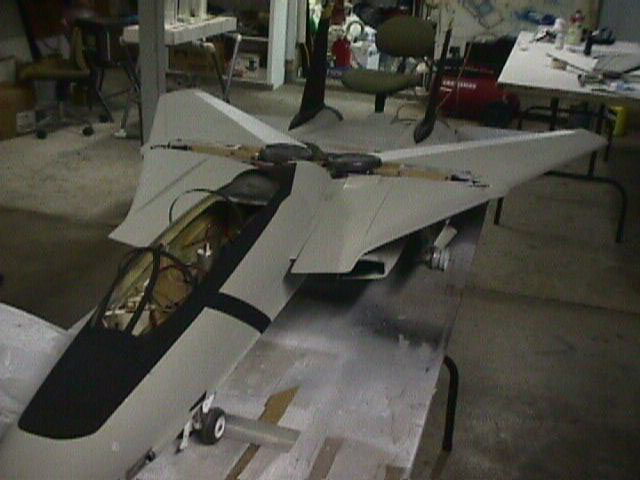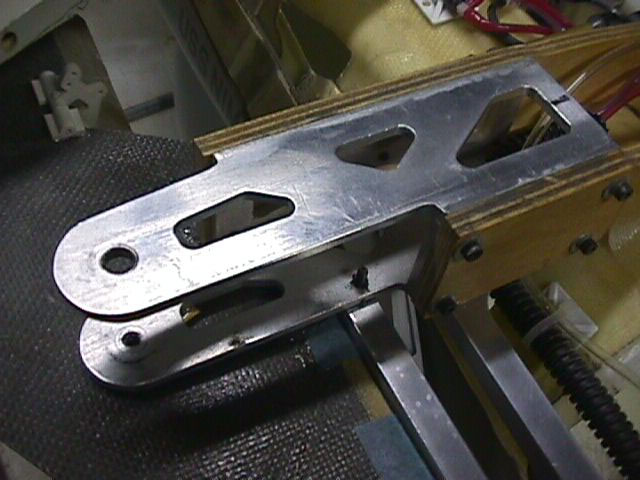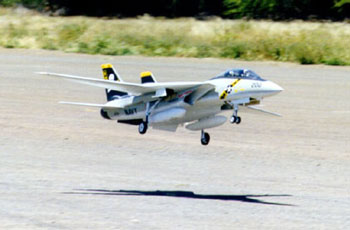Well.. what can you say about the Tomcat? Generations were born under great aircraft such as the the F4U Corsair, the F8C Crusader, the F4N Phantom II to mention a few. The Grumman F14 Tomcat is a plane few will ever forget. It's primary responsibility to protect the Carrier Group as the Navy's front line Fighter/Interceptor is currently unrivaled.
The Swing Wing, in which the Tomcat is famous for, is a rarity in models and have been a modelers nightmare for many years. Only until recently with the current state-of-the-art Radio Systems, advances in Model Manufacturing and Modern Composite Components have people started to truly look into the once thought "impossible" projects.
|
Returning to Barbers Point NAS after a successful sortie. |
|
|
Receiving
the DCU Tomcat
was, if I remember correctly, exactly how I remember Christmas morning
20 years ago. Joy! Joy! Presents! Gimme! Or something to that effect.
Well I'm sure the FedEx guy was happy just to get back to the office
and away from me! By the way, this thing came in 2 HUGE
boxes! it only (gasp) cost me about $100 bucks! (to Hawaii) I thought
it was a steal! Most other kits manufactures, like Yellow Aircraft,
charge me like $100 -$120 bucks for just shipping the F4E Phantom
II!
Mark and the people at DCU were most accommodating as far as shipping with various carriers is concerned. The kit has almost everything except for Dynamax Fans, Engines, Pipes, Radio, Glues and Paint. It might be better to say what does come in the kit: Custom Fan Mounts*, Scale Rotating Retracts, Struts, Brakes, Tires, Wing Sweep Unit with battery and charger, Fiberglass Doors, UEI Hidden Hinges (awesome stuff) and cockpit. The Wing Pivot Blocks, Bearings and Wing Box (Spar) are preset in a jig and installed at the DCU Factory. Hey even Decals from Aeroloft are included, just name the squadron when ordering your kit and its in there! Almost everything you need is there to build it as per instructions, that is, if you build per instructions. Actually, I only did a couple of modifications to the plane: 1) I put in a full scale gear door system ( which was left up to the modeler) 2) I changed the rudder linkage and hinge system, I used 2 servos, one for each rudder instead of one for both, mounted just behind each main gear. I used a Sullivan Semi-Flexible Cable linkage to the control horn. I also used the more conventional Robart Pin Hinges for the Rudder installation instead of the method used in the manual. |
|
|
Everything during construction is fairly easy, if not, calls and questions to DCU are helpful and reassuring. The images to the left is basically how the fuselage looks out of the box, molded in gray. All wood and screw parts are bagged separately for identification. Pre-installed are the nose wheel bulkhead, Main Wing Spar & Aluminum Pivot Brackets and a rear bulkhead which is to reinforce the elevon and vertical fin areas ( the elevon block is preinstalled against this bulkhead). Washing down the fuselage with warm soapy water helps remove any release agents which may still be present. |
|
| Building the Tomcat is pretty easy, just pay attention to where your equipment is going or has to be. Think "ease of maintenance" too, as it is a tight fitting bird. The only main difference I did is the rudder modification I mentioned earlier and the gear doors. | |
 |
Getting closer! Tomcat being worked on at Duke's "Skunk Works" facility. ( his garage) |
|
At full sweep, the plane is a lot different, nothing bad or anything but it is more responsive than with the wings out. Heck, there is only 1/4 inch throw for ailerons at this mode. Nothing bad as far as habits. The Tomcat can be intimidating with the coals poured on and the wings swept back. Very sinister looking during flybys down the runway. |
|
| With the wings swept to the mid swept position, it is a lot more responsive, and will probably be where most of my flying will occur, nothing abnormal here. | |
Fly this bird SCALE. Which means watch the airspeed and maneuvering and adjust wing sweep accordingly. She is easy to land and sink is predictable, the brakes come in handy here.
| Scale: | 1/10 Scale |
| Weight: | 23 lbs. |
| Avionics: | Airtronics Stylus PCM |
| Number of Channels: | 6 |
| Channel Functions: | Elevons - Elevator/Ailerons |
| Rudder | |
| Throttle | |
| Retracts | |
| Wing Sweep | |
| Brakes | |
| Engines: | (2) OS 91's, JMP throttle arms, K&B HP plugs, Sig 5% Fuel |
| Ducted Fans: | Dynamax Fans, Ramtec Pitot Power |
| Pipes: | JMP Tuned Pipes-System 2 |
| Landing Gear: | DCU Custom Scale Gear, with Scale Strut and Brake Systems |
| Construction: | Epoxyglass Fuselage reinforced with Carbon Fiber Weave, Foam Core Wings, Stabs and Vertical Fins reinforced with Carbon Fiber sheeted with Balsa |
| Finish: | 3/4 oz Fiberglass with WEST Systems Epoxy for the flying surfaces, Automotive lacquer primer and Testors Model Master Paints for the Gray's and whites. Aeroloft Markings |


Yep! I feel the need for speed already!
The plane was sprayed in a automotive primer and then shot with Testors - Model Masters Gull Grey and Flat White. I used the Topflight semi-gloss clear to proof the marking and protect the paint.
My plane finished up at 23lbs. dry weight. I think DCU estimates 21-22lbs. I had to add 10oz of lead into the nose to balance 1/2" forward of main spar, actually I believe this is a conservative mark and I will be experimenting with this as I get more comfortable with the plane.
Flying the Tomcat can best be described in two sections, wings out and wings back.
During take off, the plane rotates in about 175-200 feet, she has good power when ascending. wing roll is slower than most would be comfortable. It calls for 1 1/2 inch through but I increased them to 1 1 3/4 inch. It help a bit, but you still have to fly the Tomcat around, its best to fly it 3 steps ahead of what's currently happening.

The Wing Sweep unit (left) which is included in the kit.
Left wing Pivot Brace ( below)

